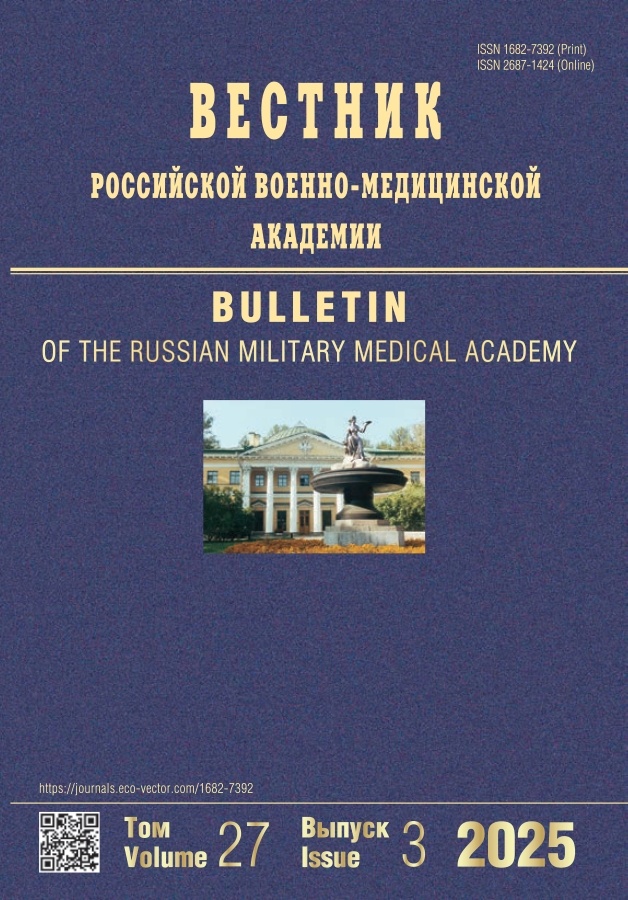Clinical characteristics of different nationalities, who committed suicide attempts and were hospitalized in a psychiatric hospital
- 作者: Mekhtiyev ES1, Abbasova SE1, Kasimov OG2, Dnov KV3
-
隶属关系:
- Главный военный клинический госпиталь Вооруженных сил Азербайджанской Республики
- Центральная военно-врачебная комиссия Министерства обороны Азербайджанской Республики
- Военно-медицинская академия им. С.М. Кирова
- 期: 卷 20, 编号 3 (2018)
- 页面: 114-118
- 栏目: Articles
- URL: https://journals.rcsi.science/1682-7392/article/view/12277
- DOI: https://doi.org/10.17816/brmma12277
- ID: 12277
如何引用文章
全文:
详细
作者简介
E Mekhtiyev
Главный военный клинический госпиталь Вооруженных сил Азербайджанской РеспубликиБаку
S Abbasova
Главный военный клинический госпиталь Вооруженных сил Азербайджанской Республики
Email: sevulya.abbasova@gmail.com
Баку
O Kasimov
Центральная военно-врачебная комиссия Министерства обороны Азербайджанской РеспубликиБаку
K Dnov
Военно-медицинская академия им. С.М. КироваСанкт-Петербург
参考
- Глазырина, Т.М. Личностные особенности мужчин призывного возраста / Т.М. Глазырина, П.А. Порожников, А.Н. Ятманов // Новая наука: Проблемы и перспективы. - 2016. - № 4-2. - C. 21-23.
- Дубравин, В.И. Этнокультуральные особенности распростра- ненности суицидов среди городского и сельского населения республики Коми / В.И. Дубравин // Культуральные и этни- ческие проблемы психического здоровья. - М. - Ижевск, 1997. - С. 315-317.
- Кажаров, М.X. Социокультурные аспекты самоубийства в Кабардино-Балкарии / М.X. Кажаров // Соц. и клин. психи- атрия. - 2005. - Т. 15, вып.1. - С. 35-39.
- Нечипоренко, В.В. Суицидология: вопросы клиники, диа- гностики и профилактики / В.В. Нечипоренко, В.К. Шамрей. - СПб.: ВМА, 2007. - 528 с.
- Положий, Б.С. Суициды в контексте этнокультуральной пси- хиатрии / Б.С. Положий // Психиатрия и фармакотерапия. - 2002. - № 6. - С. 235.
- Положий, Б.С. Клиническая суицидология. Этнокультуральные подходы / Б.С. Положий. - М.: ГНЦ ССП им. В.П. Сербского, 2006. - 207 с.
- Солодков, А.С. Особенности военно-профессиональной адаптации военнослужащих первого года службы / А.С. Солодков [и др.] // Ученые записки университета им. П.Ф. Лесгафта. - 2015. - № 9 (127). - C. 241-246.
- Сухарев, A.B. Этническая функция культуры и психические расстройства / A.B. Сухарев // Психол. журн. - 1996. - Т. 17, № 2. - С. 129-136.
- Султанов, А.А. Изучение социальных мотивов незавершенных самоубийств / А.А. Султанов, Э.Я. Гусейнбейли // Azərbaycan Psixiatriya Jurnal. - 2002. - № 1 (10). - C. 18-22.
- Тарумов, Д.А. Аналитический обзор специальных методов нейровизуализации в психиатрической практике / Д.А. Та- румов [и др.] // Вестн. новых мед. технологий. - 2018. - Т. 12. № 2. - C. 104-113.
- Шамрей, В.К. Перспективы объективного мониторинга и прогноза психического здоровья военнослужащих / В.К. Шамрей [и др.] // Доктор.Ру. - 2018. - № 1 (145). - C. 27-33.
- Canetto, S.S. Women and suicidal behavior: a cultural analysis / S.S. Canetto // Am. J. Orthopsychiatry. - 2008. - Vol. 78, № 2. - P. 259-266.
- Diyachkowa, I.S. Ethnic psychological investigation of suicidal behavior / I.S. Diyachkowa, A.I. Lazebnick, J.M. Pchelnicov // Abstracts of First International Medical Congress. - Izhevsk, 1996. - P. 36.
- Green, J. Ethnic aspects of suicide statistics / J. Green // Suicide assessment and prevention. - 1977. - Vol. 6. - P. 138-143.
- Merrill, J. Ethnic differences in self-poisoning: A comparison of Asian and wite groups / J. Merrill, J. Owens // Br. J. Psychiatry. - 1986. - Vol. 148, № 6. - P. 708-712.
- Tatai, K. Socio-cultural aspects of suicide in Japan / K. Tatai // Suicidology: Proc. of the 3th Intern. Congress of soc. psychiatry. - Zagreb, 1971. - P. 60-64.
- Wexler, L.M. Culturally responsive suicide prevention in indigenous communities: unexamined assumptions and new possibilities / L.M. Wexler, J.P. Gone // Am. J. Public Health. - 2012. - Vol. 102, № 5. - P. 800-806.
补充文件







